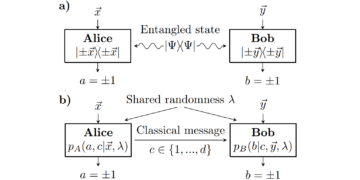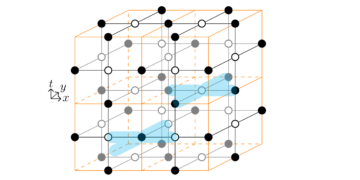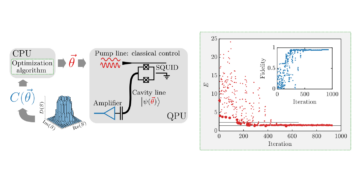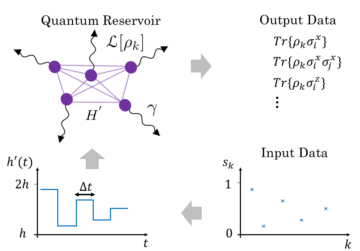
H.H. Wills Physics Laboratory, University of Bristol, Tyndall Avenue, Bristol, BS8 1TL, U.K.
Find this paper interesting or want to discuss? Scite or leave a comment on SciRate.
Abstract
We consider how to define a natural probability distribution over worlds within a simple class of deterministic many-worlds theories. This can help us understand the typical properties of worlds within such states, and hence explain the empirical success of quantum theory within a many-worlds framework. We give three reasonable axioms which lead to the Born rule in the case of quantum theory, and also yield natural results in other cases, including a many-worlds variant of classical stochastic dynamics.
► BibTeX data
► References
[1] Louis de Broglie. “La nouvelle dynamique des quanta”. in Solvay – The Fifth Council “Electrons and photons”Pages 105–132 (1928).
[2] David Bohm. “A suggested interpretation of the quantum theory in terms of “hidden” variables. i”. Phys. Rev. 85, 166–179 (1952).
https://doi.org/10.1103/PhysRev.85.166
[3] G. C. Ghirardi, A. Rimini, and T. Weber. “Unified dynamics for microscopic and macroscopic systems”. Phys. Rev. D 34, 470–491 (1986).
https://doi.org/10.1103/PhysRevD.34.470
[4] Philip Pearle. “Combining stochastic dynamical state-vector reduction with spontaneous localization”. Phys. Rev. A 39, 2277–2289 (1989).
https://doi.org/10.1103/PhysRevA.39.2277
[5] Gian Carlo Ghirardi, Philip Pearle, and Alberto Rimini. “Markov processes in hilbert space and continuous spontaneous localization of systems of identical particles”. Phys. Rev. A 42, 78–89 (1990).
https://doi.org/10.1103/PhysRevA.42.78
[6] Hugh Everett. “”relative state” formulation of quantum mechanics”. Rev. Mod. Phys. 29, 454–462 (1957).
https://doi.org/10.1103/RevModPhys.29.454
[7] Bryce S. DeWitt. “Quantum mechanics and reality”. Physics Today 23, 30–35 (1970).
https://doi.org/10.1063/1.3022331
[8] M Born. “Zur quantenmechanik der stoßvorgänge”. Z. Physik 37, 863–867 (1926).
https://doi.org/10.1007/BF01397477
[9] David Wallace. “Decoherence and ontology (or: How i learned to stop worrying and love fapp)”. In Simon Saunders, Jonathan Barrett, Adrian Kent, and David Wallace, editors, Many Worlds?: Everett, Quantum Theory, and Reality. Pages 53–72. Oxford University Press (2010).
https://doi.org/10.1093/acprof:oso/9780199560561.003.0002
[10] Valia Allori, Sheldon Goldstein, Roderich Tumulka, and Nino Zanghì. “Many worlds and schrödinger’s first quantum theory”. The British Journal for the Philosophy of Science 62, 1–27 (2011).
https://doi.org/10.1093/bjps/axp053
[11] Lev Vaidman. “Derivations of the Born rule”. In Meir Hemmo and Orly Shenker, editors, Quantum, Probability, Logic: The Work and Influence of Itamar Pitowsky. Pages 567–584. Springer Nature Switzerland AG (2020).
https://doi.org/10.1007/978-3-030-34316-3_26
[12] Lev Vaidman. “On schizophrenic experiences of the neutron or why we should believe in the many‐worlds interpretation of quantum theory”. International Studies in the Philosophy of Science 12, 245–261 (1998).
https://doi.org/10.1080/02698599808573600
[13] Lev Vaidman. “Probability in the many-worlds interpretation of quantum mechanics”. In Yemima Ben-Menahem and Meir Hemmo, editors, Probability in Physics. Pages 299–311. Springer Berlin Heidelberg, Berlin, Heidelberg (2012).
https://doi.org/10.1007/978-3-642-21329-8_18
[14] Wojciech Hubert Zurek. “Environment-assisted invariance, entanglement, and probabilities in quantum physics”. Phys. Rev. Lett. 90, 120404 (2003).
https://doi.org/10.1103/PhysRevLett.90.120404
[15] Wojciech Hubert Zurek. “Probabilities from entanglement, Born’s rule ${p}_{k}={{mid}{{psi}}_{k}{mid}}^{2}$ from envariance”. Phys. Rev. A 71, 052105 (2005).
https://doi.org/10.1103/PhysRevA.71.052105
[16] J. B. Hartle. “Quantum mechanics of individual systems”. American Journal of Physics 36, 704–712 (1968).
https://doi.org/10.1119/1.1975096
[17] David Deutsch. “Quantum theory of probability and decisions”. Proc. Roy. Soc. 455, 3129–3137 (1999).
https://doi.org/10.1098/rspa.1999.0443
[18] David Wallace. “Everettian rationality: defending Deutsch’s approach to probability in the Everett interpretation”. Stud. Hist. Philos. Sci. B 34, 415–439 (2003).
https://doi.org/10.1016/S1355-2198(03)00036-4
[19] Hilary Greaves. “Probability in the Everett interpretation”. Philosophy Compass 2, 109–128 (2007).
https://doi.org/10.1111/j.1747-9991.2006.00054.x
[20] David Wallace. “How to prove the Born rule”. In Simon Saunders, Jonathan Barrett, Adrian Kent, and David Wallace, editors, Many Worlds?: Everett, Quantum Theory, and Reality. Pages 227–263. Oxford University Press (2010).
https://doi.org/10.1093/acprof:oso/9780199560561.003.0010
[21] Hilary Greaves and Wayne Myrvold. “Everett and evidence”. In Simon Saunders, Jonathan Barrett, Adrian Kent, and David Wallace, editors, Many Worlds?: Everett, Quantum Theory, and Reality. Pages 181–205. Oxford University Press (2010).
https://doi.org/10.1093/acprof:oso/9780199560561.003.0011
[22] Adrian Kent. “One world versus many: The inadequacy of Everettian accounts of evolution, probability, and scientific confirmation”. In Simon Saunders, Jonathan Barrett, Adrian Kent, and David Wallace, editors, Many Worlds?: Everett, Quantum Theory, and Reality. Pages 307–354. Oxford University Press (2010).
https://doi.org/10.1093/acprof:oso/9780199560561.003.0012
[23] David Albert. “Probability in the Everett picture”. In Simon Saunders, Jonathan Barrett, Adrian Kent, and David Wallace, editors, Many Worlds?: Everett, Quantum Theory, and Reality. Pages 355–368. Oxford University Press (2010).
https://doi.org/10.1093/acprof:oso/9780199560561.003.0013
[24] Simon Saunders. “Branch-counting in the Everett interpretation of quantum mechanics”. Proc. Roy. Soc. A 477, 20210600 (2021).
https://doi.org/10.1098/rspa.2021.0600
[25] David Wallace. “The Emergent Multiverse: Quantum Theory according to the Everett Interpretation”. Oxford University Press. (2012).
https://doi.org/10.1093/acprof:oso/9780199546961.001.0001
[26] Dennis Dieks. “Modal interpretation of quantum mechanics, measurements, and macroscopic behavior”. Phys. Rev. A 49, 2290–2300 (1994).
https://doi.org/10.1103/PhysRevA.49.2290
[27] Scott Aaronson. “Quantum computing and hidden variables”. Phys. Rev. A 71, 032325 (2005).
https://doi.org/10.1103/PhysRevA.71.032325
[28] Samuel T. Mister, Benjamin J. Arayathel, and Anthony J. Short. “Local probability conservation in discrete-time quantum walks”. Phys. Rev. A 103, 042220 (2021).
https://doi.org/10.1103/PhysRevA.103.042220
[29] David Lewis. “A subjectivist’s guide to objective chance”. In William L. Harper, Robert Stalnaker, and Glenn Pearce, editors, IFS: Conditionals, Belief, Decision, Chance and Time. Pages 267–297. Springer Netherlands, Dordrecht (1981).
https://doi.org/10.1007/978-94-009-9117-0_14
Cited by
[1] Ed Seidewitz, “Probability and Measurement in Relativistic Quantum Mechanics”, arXiv:2209.12411, (2022).
The above citations are from SAO/NASA ADS (last updated successfully 2023-04-07 12:25:41). The list may be incomplete as not all publishers provide suitable and complete citation data.
On Crossref’s cited-by service no data on citing works was found (last attempt 2023-04-07 12:25:39).
This Paper is published in Quantum under the Creative Commons Attribution 4.0 International (CC BY 4.0) license. Copyright remains with the original copyright holders such as the authors or their institutions.
- SEO Powered Content & PR Distribution. Get Amplified Today.
- Platoblockchain. Web3 Metaverse Intelligence. Knowledge Amplified. Access Here.
- Source: https://quantum-journal.org/papers/q-2023-04-06-971/
- :is
- 1
- 10
- 11
- 1994
- 1998
- 1999
- 2011
- 2012
- 2020
- 2021
- 2022
- 28
- 39
- 7
- 8
- 9
- a
- above
- ABSTRACT
- access
- According
- Accounts
- affiliations
- AG
- All
- American
- and
- Anthony
- approach
- ARE
- AS
- author
- authors
- Avenue
- BE
- belief
- believe
- Benjamin
- berlin
- born
- Break
- bristol
- British
- by
- CAN
- case
- cases
- Chance
- class
- comment
- Commons
- Compass
- complete
- computing
- confirmation
- CONSERVATION
- Consider
- continuous
- copyright
- Council
- data
- David
- decision
- decisions
- Defending
- Den
- discuss
- distribution
- dynamics
- ed
- electrons
- Ether (ETH)
- evidence
- evolution
- Experiences
- Explain
- First
- For
- formulation
- found
- Framework
- from
- Give
- guide
- harvard
- help
- Hidden
- holders
- How
- How To
- HTTPS
- i
- identical
- in
- In other
- Including
- individual
- influence
- institutions
- interesting
- International
- interpretation
- JavaScript
- journal
- laboratory
- Last
- lead
- learned
- Leave
- Lewis
- License
- List
- Localization
- Louis
- love
- many
- measurements
- mechanics
- Month
- Multiverse
- Natural
- Nature
- Netherlands
- objective
- of
- on
- Ontology
- open
- original
- Other
- Oxford
- oxford university
- Paper
- philosophy
- Photons
- Physics
- picture
- plato
- Plato Data Intelligence
- PlatoData
- press
- probability
- PROC
- processes
- properties
- Prove
- provide
- published
- publisher
- publishers
- Quantum
- Quantum Mechanics
- quantum physics
- Reality
- reasonable
- references
- remains
- Results
- ROBERT
- Rule
- s
- Saunders
- SCI
- Science
- scott aaronson
- Short
- should
- Simon
- Simple
- Space
- State
- States
- Stop
- studies
- success
- Successfully
- such
- suitable
- switzerland
- Systems
- terms
- The
- their
- three
- time
- Title
- to
- today
- typical
- under
- understand
- university
- updated
- URL
- us
- variables
- Variant
- Versus
- volume
- which
- with
- within
- Work
- works
- world
- world’s
- X
- year
- Yield
- zephyrnet











